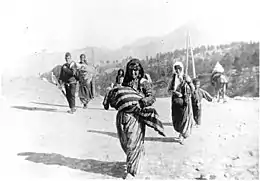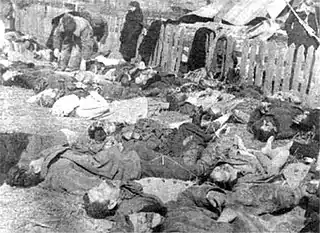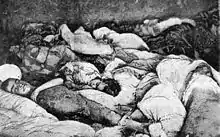Ethnic cleansing
Ethnic cleansing is the systematic forced removal or extermination of ethnic, racial and/or religious groups from a given area, often with the intent of making a region ethnically homogeneous. Along with direct removal (deportation, population transfer), it also includes indirect methods aimed at coercing the victim group to flee and preventing its return, such as murder, rape, and property destruction.[2][3][4] Although the term ethnic cleansing has no legal definition under international criminal law, it constitutes a crime against humanity and may also fall under the Genocide Convention.[2][5][6]

| Part of a series on |
| Discrimination |
|---|
 |
Ethnic cleansing is usually accompanied by efforts to remove physical and cultural evidence of the targeted group in the territory through the destruction of homes, social centers, farms, and infrastructure, as well as through the desecration of monuments, cemeteries, and places of worship.
Although many instances of ethnic cleansing have occurred throughout history, the term was first used by the perpetrators as an euphemism during the Yugoslav Wars in the 1990s. Since then it has gained widespread acceptance due to journalism and the media's heightened use of the term in its generic meaning.[7]
Etymology
An antecedent to the term is the Greek word andrapodismos (Greek: ἀνδραποδισμός; lit. "enslavement"), which was used in ancient texts to describe atrocities that accompanied Alexander the Great's conquest of Thebes in 335 BC.[8] In the early 1900s, regional variants of the term could be found among the Czechs (očista), the Poles (czystki etniczne), the French (épuration) and the Germans (Säuberung).[9] A 1913 Carnegie Endowment report condemning the actions of all participants in the Balkan Wars contained various new terms to describe brutalities committed toward ethnic groups.[10]

During World War II, the euphemism čišćenje terena ("cleansing the terrain") was used by the Croatian Ustaše to describe military actions in which non-Croats were purposely killed or otherwise uprooted from their homes.[11] Viktor Gutić, a senior Ustaše leader, was one of the first Croatian nationalists on record to use the term as a euphemism for committing atrocities against Serbs.[12] The term was later used in the internal memorandums of Serbian Chetniks in reference to a number of retaliatory massacres they committed against Bosniaks and Croats between 1941 and 1945.[13] The Russian phrase очистка границ (ochistka granits; lit. "cleansing of borders") was used in Soviet documents of the early 1930s to refer to the forced resettlement of Polish people from the 22-kilometre (14 mi) border zone in the Byelorussian and Ukrainian SSRs. This process was repeated on an even larger scale in 1939–41, involving many other groups suspected of disloyalty towards the Soviet Union.[14] During The Holocaust, Nazi Germany pursued a policy of ensuring that Europe was "cleansed of Jews" (Judenrein).[15]
In its complete form, the term appeared for the first time in the Romanian language (purificare etnică) in an address by Vice Prime Minister Mihai Antonescu to cabinet members in July 1941. After the beginning of the invasion of the USSR, he concluded: “I do not know when the Romanians will have such chance for ethnic cleansing."[16] In the 1980s, the Soviets used the term "ethnic cleansing" to describe the inter-ethnic violence in Nagorno-Karabakh.[8] At around the same time, the Yugoslav media used it to describe what they alleged was an Albanian nationalist plot to force all Serbs to leave Kosovo. It was widely popularized by the Western media during the Bosnian War (1992–95). The first recorded mention of its use in the Western media can be traced back to an article in The New York Times dated 15 April 1992, in a quote by an anonymous Western diplomat.[11]
Synonyms include ethnic purification.[17]
Definitions

The Final Report of the Commission of Experts established pursuant to Security Council Resolution 780 defined ethnic cleansing as "a purposeful policy designed by one ethnic or religious group to remove by violent and terror-inspiring means the civilian population of another ethnic or religious group from certain geographic areas".[18] In its previous, first interim report it noted, "based on the many reports describing the policy and practices conducted in the former Yugoslavia, [that] 'ethnic cleansing' has been carried out by means of murder, torture, arbitrary arrest and detention, extra-judicial executions, rape and sexual assaults, confinement of civilian population in ghetto areas, forcible removal, displacement and deportation of civilian population, deliberate military attacks or threats of attacks on civilians and civilian areas, and wanton destruction of property. Those practices constitute crimes against humanity and can be assimilated to specific war crimes. Furthermore, such acts could also fall within the meaning of the Genocide Convention."[19]
The official United Nations definition of ethnic cleansing is "rendering an area ethnically homogeneous by using force or intimidation to remove from a given area persons of another ethnic or religious group".[20]
As a category, ethnic cleansing encompasses a continuum or spectrum of policies. In the words of Andrew Bell-Fialkoff:
[E]thnic cleansing [...] defies easy definition. At one end it is virtually indistinguishable from forced emigration and population exchange while at the other it merges with deportation and genocide. At the most general level, however, ethnic cleansing can be understood as the expulsion of a population from a given territory.[21]
Terry Martin has defined ethnic cleansing as "the forcible removal of an ethnically defined population from a given territory" and as "occupying the central part of a continuum between genocide on one end and nonviolent pressured ethnic emigration on the other end".[14]
In reviewing the International Court of Justice (ICJ) Bosnian Genocide Case in the judgement of Jorgic v. Germany on July 12, 2007 the European Court of Human Rights quoted from the ICJ ruling on the Bosnian Genocide Case to draw a distinction between ethnic cleansing and genocide:
The term 'ethnic cleansing' has frequently been employed to refer to the events in Bosnia and Herzegovina which are the subject of this case ... [UN] General Assembly resolution 47/121 referred in its Preamble to 'the abhorrent policy of "ethnic cleansing", which is a form of genocide', as being carried on in Bosnia and Herzegovina. ... It [i.e., ethnic cleansing] can only be a form of genocide within the meaning of the [Genocide] Convention, if it corresponds to or falls within one of the categories of acts prohibited by Article II of the Convention. Neither the intent, as a matter of policy, to render an area "ethnically homogeneous", nor the operations that may be carried out to implement such policy, can as such be designated as genocide: the intent that characterizes genocide is "to destroy, in whole or in part" a particular group, and deportation or displacement of the members of a group, even if effected by force, is not necessarily equivalent to destruction of that group, nor is such destruction an automatic consequence of the displacement. This is not to say that acts described as 'ethnic cleansing' may never constitute genocide, if they are such as to be characterized as, for example, 'deliberately inflicting on the group conditions of life calculated to bring about its physical destruction in whole or in part', contrary to Article II, paragraph (c), of the Convention, provided such action is carried out with the necessary specific intent (dolus specialis), that is to say with a view to the destruction of the group, as distinct from its removal from the region. As the ICTY has observed, while 'there are obvious similarities between a genocidal policy and the policy commonly known as 'ethnic cleansing' (Krstić, IT-98-33-T, Trial Chamber Judgment, 2 August 2001, para. 562), yet '[a] clear distinction must be drawn between physical destruction and mere dissolution of a group. The expulsion of a group or part of a group does not in itself suffice for genocide.'
— ECHR quoting the ICJ.[22]
As a crime under international law
There is no international treaty that specifies a specific crime of ethnic cleansing.[23] However, ethnic cleansing in the broad sense—the forcible deportation of a population—is defined as a crime against humanity under the statutes of both the International Criminal Court (ICC) and the International Criminal Tribunal for the Former Yugoslavia (ICTY).[24] The gross human-rights violations integral to stricter definitions of ethnic cleansing are treated as separate crimes falling under public international law of crimes against humanity and in certain circumstances genocide.[25]
There are however situations, such as the expulsion of Germans after World War II, where ethnic cleansing has taken place without legal redress (see Preussische Treuhand v. Poland). Timothy V. Waters argues therefore that similar ethnic cleansing could go unpunished in the future.[26]
Causes
Some say that failed states see most mass killing, often in an anarchic manner. According to Michael Mann (sociologist), in The Dark Side of Democracy (2004), murderous ethnic cleansing is strongly related to the creation of democracies. He argues that murderous ethnic cleansing is due to the rise of nationalism, which associates citizenship with a specific ethnic group. Democracy, therefore, is tied to ethnic and national forms of exclusion. Nevertheless, it is not democratic states that are more prone to commit ethnic cleansing, because minorities tend to have constitutional guarantees. Neither are stable authoritarian regimes (except the nazi and communist regimes) which are likely perpetrators of murderous ethnic cleansing, but those regimes that are in process of democratization. Ethnic hostility appears where ethnicity overshadows social classes as the primordial system of social stratification. Usually, in deeply divided societies, categories such as class and ethnicity are deeply intertwined, and when an ethnic group is seen as oppressor or exploitative of the other, serious ethnic conflict can develop. Michael Mann holds that when two ethnic groups claim sovereignty over the same territory and can feel threatened, their differences can lead to severe grievances and danger of ethnic cleansing. The perpetration of murderous ethnic cleansing tends to occur in unstable geopolitical environments and in contexts of war. As ethnic cleansing requires high levels of organisation and is usually directed by states or other authoritative powers, perpetrators are usually state powers or institutions with some coherence and capacity, not failed states as it is generally perceived. The perpetrator powers tend to get support by core constituencies that favour combinations of nationalism, statism and violence.[27]
Genocide

Ethnic cleansing is part of a continuum of violence whose most extreme form is genocide, where the perpetrator's goal is the destruction of the targeted group. Ethnic cleansing is similar to forced deportation or population transfer whereas genocide is the attempt to destroy part or all of a particular ethnic, racial, religious, or national group. While ethnic cleansing and genocide may share the same goal and the acts which are used to perpetrate both crimes may often resemble each other, ethnic cleansing is intended to displace a persecuted population from a given territory, while genocide is intended to destroy a group.[28][29]
Some academics consider genocide to be a subset of "murderous ethnic cleansing".[30] Thus, these concepts are different, but related, as Norman Naimark writes: "literally and figuratively, ethnic cleansing bleeds into genocide, as mass murder is committed in order to rid the land of a people".[31] William Schabas adds, "Ethnic cleansing is also a warning sign of genocide to come. Genocide is the last resort of the frustrated ethnic cleanser."[28]
As a military, political and economic tactic
As a tactic, ethnic cleansing has a number of systemic impacts. It enables a force to eliminate civilian support for resistance by eliminating the civilians—recognizing Mao Zedong's dictum that guerrillas among a civilian population are fish in water, it removes the fish by draining the water. When enforced as part of a political settlement, as happened with the forced resettlement of ethnic Germans to Germany in its reduced borders after 1945, it can contribute to long-term stability.[32] Some individuals of the large German population in Czechoslovakia and prewar Poland had encouraged Nazi jingoism before the Second World War, but this was forcibly resolved.[33] It thus establishes "facts on the ground"—radical demographic changes which can be very hard to reverse.
Instances
See List of ethnic cleansing campaigns for a list of events often referred to as instances of ethnic cleansings. In many cases, the side perpetrating the alleged ethnic cleansing and its allies have fiercely disputed the charge.
Criticism of the term
Gregory Stanton, the founder of Genocide Watch, has criticised the rise of the term and its use for events that he feels should be called "genocide": because "ethnic cleansing" has no legal definition, its media use can detract attention from events that should be prosecuted as genocide.[34][35] Because of widespread acceptance after media influence, it has become a word used legally, but carries no legal repercussions. [36]
In 1992, the German equivalent of "ethnic cleansing" (German: Ethnische Säuberung) was named German Un-Word of the Year by the Gesellschaft für deutsche Sprache due to its euphemistic, inappropriate nature.[37]
See also
- Classicide
- Communal violence
- Crimes against humanity
- Democide
- Ethnic Cleansing, a computer game
- Ethnocide
- Eugenics
- Forced displacement
- Genocidal massacre
- Identity cleansing
- Indian Removal Act
- Linguicide
- Missouri Executive Order 44
- Monoethnicity
- Politicide
- Population transfer
- Religious cleansing
- Rule of Law in Armed Conflicts Project (RULAC)
- Social cleansing
- State collapse
- Transmigration program
Notes
- Akçam, Taner (2011). "Demographic Policy and the Annihilation of the Armenians". The Young Turks' Crime Against Humanity: The Armenian Genocide and Ethnic Cleansing in the Ottoman Empire. Princeton University Press. ISBN 978-0-691-15333-9.
The thesis being proposed here is that the Armenian Genocide was not implemented solely as demographic engineering, but also as destruction and annihilation, and that the 5 to 10 percent principle was decisive in achieving this goal. Care was taken so that the number of Armenians deported to Syria, and those who remained behind, would not exceed 5 to 10 percent of the population of the places in which they were found. Such a result could be achieved only through annihilation... According to official Ottoman statistics, it was necessary to reduce the prewar population of 1.3 million Armenians to approximately 200,000.
- "Ethnic cleansing". www.un.org. United Nations Office on Genocide Prevention and the Responsibility to Protect. Retrieved December 20, 2020.
- Walling, Carrie Booth (2000). "The history and politics of ethnic cleansing". The International Journal of Human Rights. 4 (3–4): 47–66. doi:10.1080/13642980008406892.
Most frequently, however, the aim of ethnic cleansing is to expel the despised ethnic group through either indirect coercion or direct force, and to ensure that return is impossible. Terror is the fundamental method used to achieve this end.
Methods of indirect coercion can include: introducing repressive laws and discriminatory measures designed to make minority life difficult; the deliberate failure to prevent mob violence against ethnic minorities; using surrogates to inflict violence; the destruction of the physical infrastructure upon which minority life depends; the imprisonment of male members of the ethnic group; threats to rape female members, and threats to kill. If ineffective, these indirect methods are often escalated to coerced emigration, where the removal of the ethnic group from the territory is pressured by physical force. This typically includes physical harassment and the expropriation of property. Deportation is an escalated form of direct coercion in that the forcible removal of 'undesirables' from the state's territory is organised, directed and carried out by state agents. The most serious of the direct methods, excluding genocide, is murderous cleansing, which entails the brutal and often public murder of some few in order to compel flight of the remaining group members.13 Unlike during genocide, when murder is intended to be total and an end in itself, murderous cleansing is used as a tool towards the larger aim of expelling survivors from the territory. The process can be made complete by revoking the citizenship of those who emigrate or flee. - Schabas, William A. (2003). "'Ethnic Cleansing' and Genocide: Similarities and Distinctions". European Yearbook of Minority Issues Online. 3 (1): 109–128. doi:10.1163/221161104X00075.
The Commission considered techniques of ethnic cleansing to include murder, torture, arbitrary arrest and detention, extrajudicial executions, sexual assault, confinement of civilian populations in ghetto areas, forcible removal, displacement and deportation of civilian populations, deliberate military attacks or threats of attacks on civilians and civilian areas, and wanton destruction of property.
- Jones, Adam (2012). "'Ethnic cleansing' and genocide". Crimes Against Humanity: A Beginner's Guide. Simon and Schuster. ISBN 978-1-78074-146-8.
- Schabas, William A. (2003). "'Ethnic Cleansing' and Genocide: Similarities and Distinctions". European Yearbook of Minority Issues Online. 3 (1): 109–128. doi:10.1163/221161104X00075.
'Ethnic cleansing' is probably better described as a popular or journalistic expression, with no recognized legal meaning in a technical sense... 'ethnic cleansing' is equivalent to deportation,' a grave breach of the Geneva Conventions as well as a crime against humanity, and therefore a crime within the jurisdiction of the Tribunal.
- Thum 2010, p. 75: way. Despite its euphemistic character and its origin in the language of the perpetrators, 'ethnic cleansing' is now the widely accepted scholarly term used to describe the systematic and violent removal of undesired ethnic groups from a given territory.
- Booth, Ken (2012). The Kosovo Tragedy: The Human Rights Dimensions. London: Routledge. p. 48. ISBN 978-1-13633-476-4.
- Ther, Philip (2004). "The Spell of the Homogeneous Nation State: Structural Factors and Agents of Ethnic Cleansing". In Rainer Munz; Rainer Ohliger (eds.). Diasporas and Ethnic Migrants: Germany, Israel and Russia in Comparative Perspective. London: Routledge. ISBN 978-1-13575-938-4. Archived from the original on January 26, 2020. Retrieved August 31, 2017.
- Akhund, Nadine (December 31, 2012). "The Two Carnegie Reports: From the Balkan Expedition of 1913 to the Albanian Trip of 1921". Balkanologie. Revue d'études pluridisciplinaires (Vol. XIV, n° 1–2). Archived from the original on April 4, 2017. Retrieved April 3, 2017 – via balkanologie.revues.org.
- Toal, Gerard; Dahlman, Carl T. (2011). Bosnia Remade: Ethnic Cleansing and Its Reversal. New York: Oxford University Press. p. 3. ISBN 978-0-19-973036-0. Archived from the original on July 6, 2014. Retrieved March 1, 2016.
- West, Richard (1994). Tito and the Rise and Fall of Yugoslavia. New York: Carroll & Graf. p. 93. ISBN 978-0-7867-0332-6.
- Becirevic, Edina (2014). Genocide on the River Drina. New Haven, Connecticut: Yale University Press. pp. 22–23. ISBN 978-0-3001-9258-2. Archived from the original on January 26, 2020. Retrieved August 31, 2017.
- Martin, Terry (1998). "The Origins of Soviet Ethnic Cleansing" Archived July 24, 2019, at the Wayback Machine. The Journal of Modern History 70 (4), 813–861. pg. 822
- Fulbrooke, Mary (2004). A Concise History of Germany. Cambridge: Cambridge University Press. p. 197. ISBN 978-0-52154-071-1. Archived from the original on January 26, 2020. Retrieved August 31, 2017.
- Petrovic, Vladimir (2017). Ethnopolitical Temptations Reach Southeastern Europe: Wartime Policy Papers of Vasa Čubrilović and Sabin Manuilă. CEU Press.
- Petrovic, Drazen (1994). "Ethnic Cleansing – An Attempt at Methodology" (PDF). European Journal of International Law. 5 (3): 343. doi:10.1093/oxfordjournals.ejil.a035875. Archived (PDF) from the original on December 22, 2018. Retrieved May 20, 2006.
In English, reference is also made to 'ethnic purification'.
- "Final Report of the Commission of Experts Established Pursuant to United Nations Security Council Resolution 780 (1992)" (PDF). United Nations Security Council. May 27, 1994. p. 33. Archived from the original on May 14, 2011. Retrieved May 25, 2020.
Upon examination of reported information, specific studies and investigations, the Commission confirms its earlier view that 'ethnic cleansing' is a purposeful policy designed by one ethnic or religious group to remove by violent and terror-inspiring means the civilian population of another ethnic or religious group from certain geographic areas. To a large extent, it is carried out in the name of misguided nationalism, historic grievances and a powerful driving sense of revenge. This purpose appears to be the occupation of territory to the exclusion of the purged group or groups. This policy and the practices of warring factions are described separately in the following paragraphs.
Paragraph 130. - "Final Report of the Commission of Experts Established Pursuant to United Nations Security Council Resolution 780 (1992)" (PDF). United Nations Security Council. May 27, 1994. p. 33. Archived from the original on May 14, 2011. Retrieved May 25, 2020. Paragraph 129
- Hayden, Robert M. (1996) "Schindler's Fate: Genocide, Ethnic Cleansing, and Population Transfers" Archived April 11, 2016, at the Wayback Machine. Slavic Review 55 (4), 727–48.
- Andrew Bell-Fialkoff, "A Brief History of Ethnic Cleansing" Archived February 3, 2004, at the Wayback Machine, Foreign Affairs 72 (3): 110, Summer 1993. Retrieved May 20, 2006.
- ECHR Jorgic v. Germany Archived September 20, 2017, at the Wayback Machine §45 citing Bosnia and Herzegovina v. Serbia and Montenegro ("Case concerning application of the Convention on the Prevention and Punishment of the Crime of Genocide"), the International Court of Justice (ICJ) found under the heading of “intent and ‘ethnic cleansing’” (at § 190)
- Ferdinandusse, Ward (2004). "The Interaction of National and International Approaches in the Repression of International Crimes" (PDF). The European Journal of International Law. 15 (5): 1042, note 7. doi:10.1093/ejil/15.5.1041. Archived from the original (PDF) on July 5, 2008.
- "Rome Statute of the International Criminal Court" Archived January 13, 2008, at the Wayback Machine, Article 7; Updated Statute of the International Criminal Tribunal for the Former Yugoslavia Archived August 6, 2009, at the Wayback Machine, Article 5.
- Shraga, Daphna; Zacklin, Ralph (2004). "The International Criminal Tribunal for the Former Yugoslavia". The European Journal of International Law. 15 (3). Archived from the original on September 27, 2007.
- Timothy V. Waters, "On the Legal Construction of Ethnic Cleansing" Archived November 6, 2018, at the Wayback Machine, Paper 951, 2006, University of Mississippi School of Law. Retrieved on 2006, 12–13
- Archived May 3, 2020, at the Wayback Machine, Mann, Michael (2005), The Dark Side of Democracy: Explaining Ethnic Cleansing. Cambridge: Cambridge University Press, Ch. 1 “The Argument,” pp. 1-33.
- Schabas, William (2000). Genocide in International Law. Cambridge: Cambridge University Press. pp. 199–201. ISBN 9780521787901. Archived from the original on January 2, 2016. Retrieved October 29, 2015.
- Ethnic cleansing versus genocide:
- Lieberman, Benjamin (2010). "'Ethnic cleansing' versus genocide?". In Bloxham, Donald; Moses, A. Dirk (eds.). The Oxford Handbook of Genocide Studies. Oxford University Press. ISBN 978-0-19-923211-6.
Explaining the relationship between ethnic cleansing and genocide has caused controversy. Ethnic cleansing shares with genocide the goal of achieving purity but the two can differ in their ultimate aims: ethnic cleansing seeks the forced removal of an undesired group or groups where genocide pursues the group’s ‘destruction’. Ethnic cleansing and genocide therefore fall along a spectrum of violence against groups with genocide lying on the far end of the spectrum.
- Martin, Terry (1998). "The Origins of Soviet Ethnic Cleansing". The Journal of Modern History. 70 (4): 813–861. doi:10.1086/235168. ISSN 0022-2801.
When murder itself becomes the primary goal, it is typically called genocide... Ethnic cleansing is probably best understood as occupying the central part of a continuum between genocide on one end and nonviolent pressured ethnic emigration on the other end. Given this continuum, there will always be ambiguity as to when ethnic cleansing shades into genocide
- Schabas, William A. (2003). "'Ethnic Cleansing' and Genocide: Similarities and Distinctions". European Yearbook of Minority Issues Online. 3 (1): 109–128. doi:10.1163/221161104X00075.
The crime of genocide is aimed at the intentional destruction of an ethnic group. 'Ethnic cleansing' would seem to be targeted at something different, the expulsion of a group with a view to encouraging or at least tolerating its survival elsewhere. Yet ethnic cleansing may well have the effect of rendering the continued existence of a group impossible, thereby effecting its destruction. In other words, forcible deportation may achieve the same result as extermination camps.
- Walling, Carrie Booth (2000). "The history and politics of ethnic cleansing". The International Journal of Human Rights. 4 (3–4): 47–66. doi:10.1080/13642980008406892.
These methods are a part of a wider continuum ranging from genocide at one extreme to emigration under pressure at the other... It is important - politically and legally - to distinguish between genocide and ethnic cleansing. The goal of the former is extermination: the complete annihilation of an ethnic, national or racial group. It contains both a physical element (acts such as murder) and a mental element (those acts are undertaken to destroy, in whole or in part, the said group). Ethnic cleansing involves population expulsions, sometimes accompanied by murder, but its aim is consolidation of power over territory, not the destruction of a complete people.
- Naimark, Norman M. (2002). Fires of Hatred. Harvard University Press. pp. 2–5. ISBN 978-0-674-00994-3.
A new term was needed because ethnic cleansing and genocide two different activities, and the differences between them are important. As in the case of determining first-degree murder, intentionality is a critical distinction. Genocide is the intentional killing off of part or all of an ethnic, religious, or national group; the murder of a people or peoples (in German, Völkermord) is the objective. The intention of ethnic cleansing is to remove a people and often all traces of them from a concrete territory. The goal, in other words, is to get rid of the "alien" nationality, ethnic, or religious group and to seize control of the territory it had formerly inhabited. At one extreme of its spectrum, ethnic cleansing is closer to forced deportation or what has been called "population transfer"; the idea is to get people to move, and the means are meant to be legal and semi-legal. At the other extreme, however, ethnic cleansing and genocide are distinguishable only by the ultimate intent. Here, both literally and figuratively, ethnic cleansing bleeds into genocide, as mass murder is committed in order to rid the land of a people.
- Hayden, Robert M. (1996). "Schindler's Fate: Genocide, Ethnic Cleansing, and Population Transfers". Slavic Review. 55 (4): 727–748. doi:10.2307/2501233. ISSN 0037-6779.
Hitler wanted the Jews utterly exterminated, not simply driven from particular places. Ethnic cleansing, on the other hand, involves removals rather than extermination and is not exceptional but rather common in particular circumstances.
- Lieberman, Benjamin (2010). "'Ethnic cleansing' versus genocide?". In Bloxham, Donald; Moses, A. Dirk (eds.). The Oxford Handbook of Genocide Studies. Oxford University Press. ISBN 978-0-19-923211-6.
- Mann, Michael (2005). The Dark Side of Democracy: Explaining Ethnic Cleansing. Cambridge: Cambridge University Press. p. 17. ISBN 9780521538541. Archived from the original on January 2, 2016. Retrieved October 29, 2015.
- Naimark, Norman (November 4, 2007). "Theoretical Paper: Ethnic Cleansing". Online Encyclopedia of Mass Violence. Archived from the original on March 6, 2016.
- Judt, Tony. Postwar: A History of Europe Since 1945 Penguin Press, 2005
- Tony Judt Postwar: A History of Europe Since 1945 Penguin Press, 2005.
- Blum, Rony; Stanton, Gregory H.; Sagi, Shira; Richter, Elihu D. (2007). "'Ethnic cleansing' bleaches the atrocities of genocide". European Journal of Public Health. 18 (2): 204–209. doi:10.1093/eurpub/ckm011. PMID 17513346.
- See also "Ethnic Cleansing and Genocidal Intent: A Failure of Judicial Interpretation?", Genocide Studies and Prevention 5, 1 (April 2010), Douglas Singleterry
- "Ethnic Cleansing Law and Legal Definition | USLegal, Inc". definitions.uslegal.com. Retrieved February 27, 2019.
- Gunkel, Christoph (October 31, 2010). "Ein Jahr, ein (Un-)Wort!" [One year, one (un)word!]. Spiegel Online (in German). Archived from the original on May 12, 2013. Retrieved February 17, 2013.
References
- Bell-Fialkoff, Andrew (1993). "A Brief History of Ethnic Cleansing". Foreign Affairs. 72 (3): 110–121. doi:10.2307/20045626. JSTOR 20045626. Archived from the original on February 3, 2004.
- Petrovic, Drazen (1998). "Ethnic Cleansing – An Attempt at Methodology" (PDF). European Journal of International Law. 5 (4): 817.
- Thum, Gregor (2010). "Review: Ethnic Cleansing in Eastern Europe after 1945". Contemporary European History. 19 (1): 75–81. doi:10.1017/S0960777309990257.
- Vladimir Petrović (2007), Etnicizacija čišćenja u reči i nedelu (Ethnicisation of Cleansing), Hereticus 1/2007, 11–36
Further reading
| Library resources about Ethnic cleansing |
- Anderson, Gary Clayton. Ethnic Cleansing and the Indians: The Crime that Should Haunt America. Norman, Oklahoma: University of Oklahoma Press, 2014.
- de Zayas, Alfred M.: Nemesis at Potsdam, Routledge, London 1977.
- de Zayas, Alfred M.: A Terrible Revenge. Palgrave/Macmillan, New York, 1994. ISBN 1-4039-7308-3.
- de Zayas, Alfred M.: Die deutschen Vertriebenen. Leopold Stocker, Graz, 2006. ISBN 3-902475-15-3.
- de Zayas, Alfred M.: Heimatrecht ist Menschenrecht. Universitas, München 2001. ISBN 3-8004-1416-3.
- de Zayas, Alfred M.: "The Right to One's Homeland, Ethnic Cleansing and the International Criminal Tribunal for the Former Yugoslavia", Criminal Law Forum (2005)
- de Zayas, Alfred M.: "Forced Population Transfer" in Max Planck Encyclopedia of Public International Law, Oxford online 2010.
- Carmichael, Cathie (2002). Ethnic cleansing in the Balkans: nationalism and the destruction of tradition (Illustrated ed.). Routledge. ISBN 0-415-27416-8.
- Douglas, R. M.: Orderly and Humane: The Expulsion of the Germans after the Second World War. Yale University Press, 2012 ISBN 978-0300166606.
- Kamusella, Tomasz. 2018. Ethnic Cleansing During the Cold War: The Forgotten 1989 Expulsion of Turks from Communist Bulgaria (Ser: Routledge Studies in Modern European History). London: Routledge, 328pp. ISBN 9781138480520.
- Prauser, Steffen and Rees, Arfon: The Expulsion of the "German" Communities from Eastern Europe at the End of the Second Century. Florence, Italy, European University Institute, 2004.
- Sundhaussen, Holm (2010). "Forced Ethnic Migration". European History Online.
- Štrbac, Savo (2015). Gone with the Storm: A Chronicle of Ethnic Cleansing of Serbs from Croatia. Knin-Banja Luka-Beograd: Grafid, DIC Veritas. ISBN 9789995589806.
External links
| Wikimedia Commons has media related to ethnic cleansing. |
| Look up ethnic cleansing in Wiktionary, the free dictionary. |
- Genocide of The Ethnic Germans in Yugoslavia 1944–1948
- Photojournalist's Account – Images of ethnic cleansing in Sudan
- Timothy V. Waters, On the Legal Construction of Ethnic Cleansing, Paper 951, 2006, University of Mississippi School of Law (PDF)
- Dump the "ethnic cleansing" jargon, group implores May 31, 2007, World Science
- Repa, Jan (March 29, 1999). "Ethnic cleansing: Revival of an old tradition". BBC News.